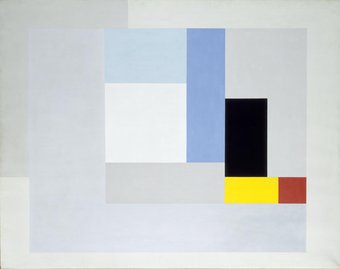
Ben Nicholson OM, June 1937 (painting) 1937. Tate. © Angela Verren Taunt 2023. All rights reserved, DACS.
International Modern 1930–1940
17 rooms in Historic and Early Modern British Art
During the 1930s, many British artists develop modern abstract art, a radical movement born of international friendships and allegiances
As the threat of war rises again throughout Europe, the importance of international artistic networks grows. British artists Barbara Hepworth, Marlow Moss, Ben Nicholson and Paule Vézelay are members of the Abstraction-Création group in Paris. They frequently travel to meet other members. They work together on publications and exhibitions. The group is set up to promote abstract art as a universal language, which they believe everyone can make and understand. Abstract art uses geometric shapes, simplified forms and colours to achieve its effect rather than accurately depicting a visual reality.
Some international artists make Britain their home in the lead-up to the Second World War. They bring with them the idea that abstract art should reject the past and imagine a more perfect future. Naum Gabo arrives in Britain from the Soviet Union. Piet Mondrian comes from the Netherlands. Gabo is especially instrumental in aiding the development of a radical abstract art movement called ‘Constructivism’. Constructivists believe that art should directly reflect the modern world, and that abstract art could be at the service of a revolutionary society. When war is declared between Britain and Germany in 1939, Gabo moves, together with Hepworth, Nicholson and their children, to the safety of St Ives in Cornwall. After the war this becomes a significant artistic community.
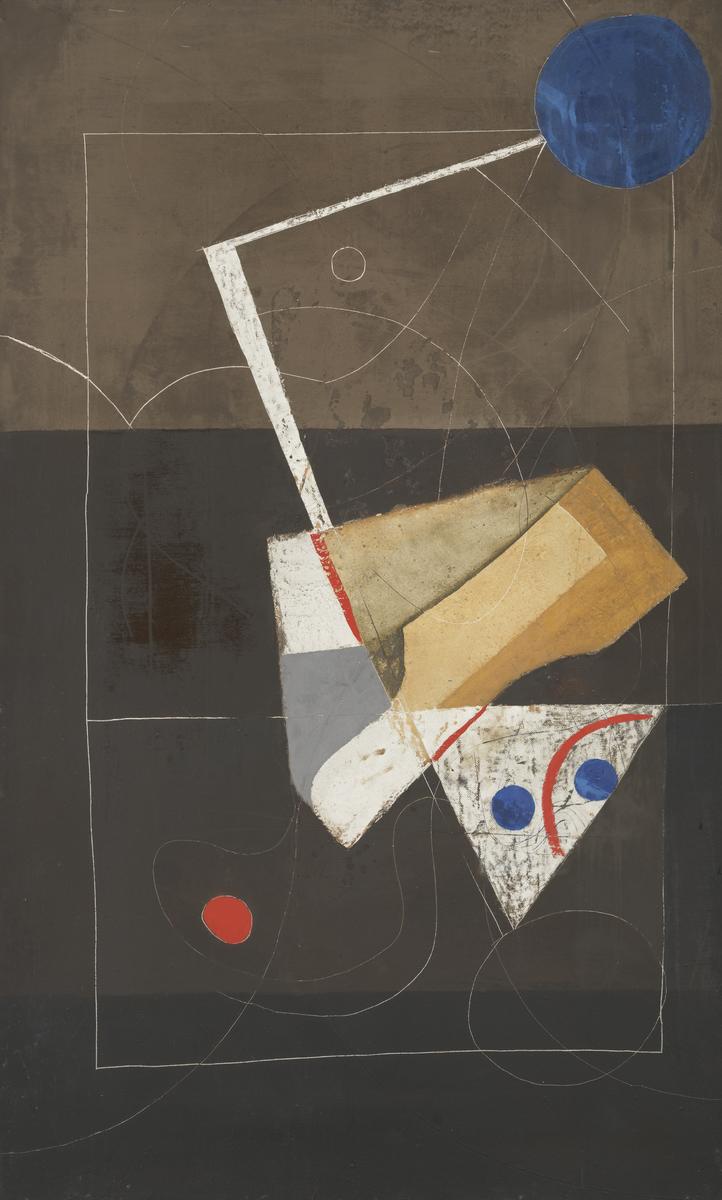
Ben Nicholson OM, 1933 (milk and plain chocolate) 1933
Here Nicholson floats circles, triangles and other shapes on a dark and milk chocolate coloured background. He creates a sense of rhythm and movement through the use of contrasting blue and red dots and straight and arcing scored white lines. These lines were produced by scratching through paint to reveal a white layer beneath. For Nicholson, this technique emphasised the painting’s materials and its status as an object in its own right. In 1934, he described his process as a way of creating ‘a living thing as nice as a poodle with two shining black eyes.’
Gallery label, October 2020
1/14
artworks in International Modern
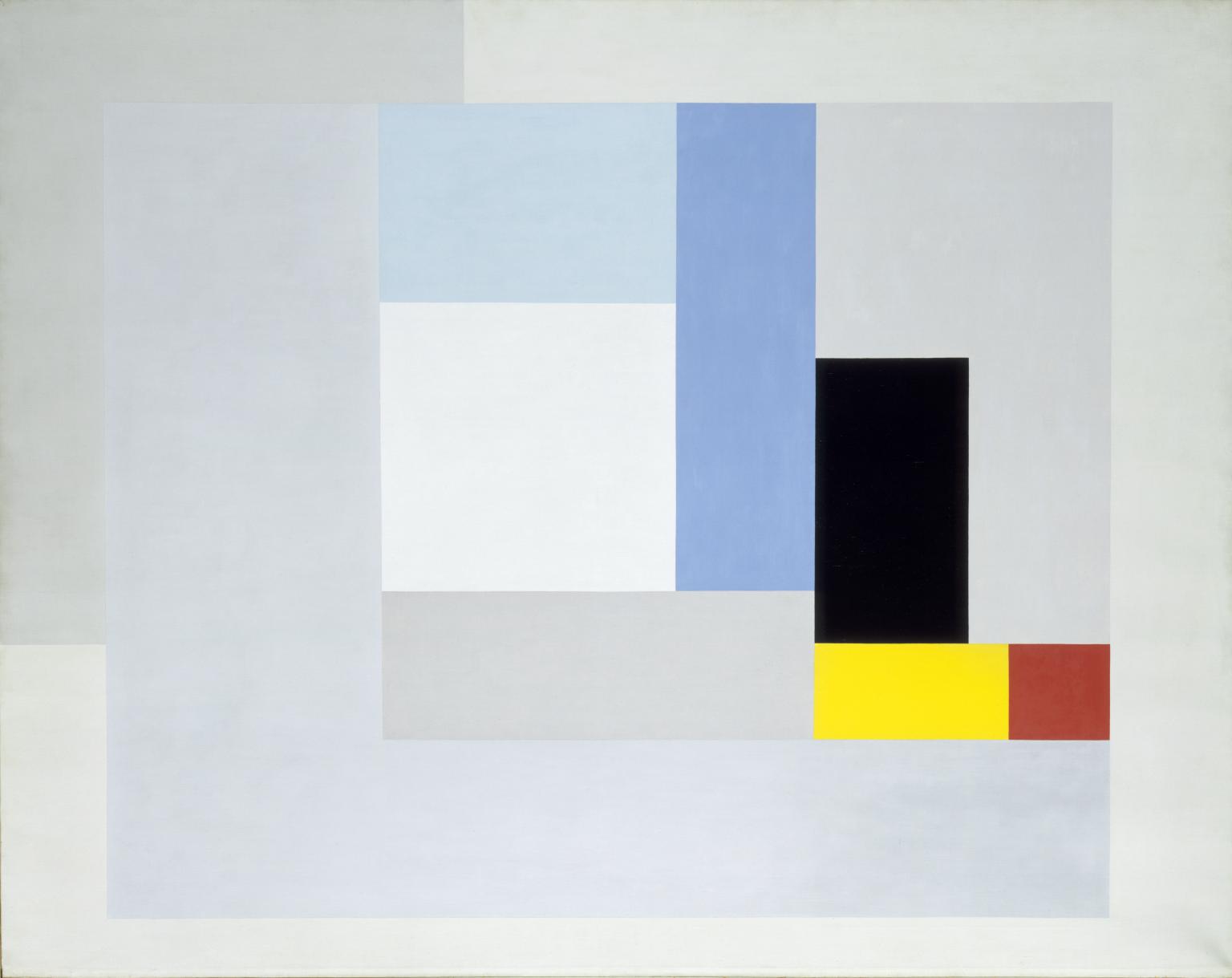
Ben Nicholson OM, June 1937 (painting) 1937
After his first visit to Piet Mondrian’s Paris studio in 1934, Nicholson wrote: ‘[T]he thing I remembered most was the feeling of light ... The feeling in his studio must have been not unlike the feeling in one of those hermit’s caves where lions used to go to have thorns taken out of their paws.’ Shortly afterwards Nicholson started to paint rectilinear arrangements in primary colours and tones of blue, grey and white.
Gallery label, February 2010
2/14
artworks in International Modern
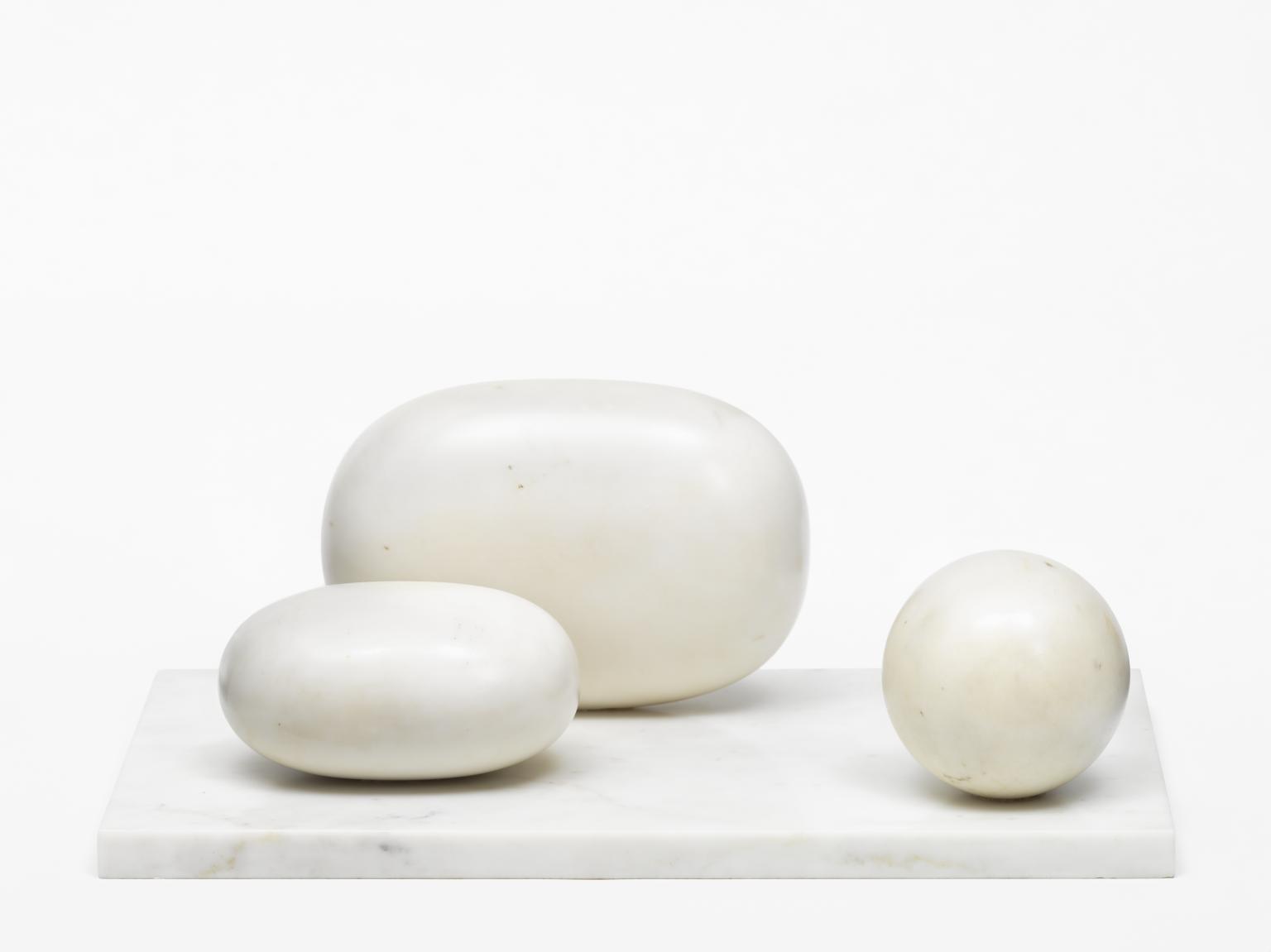
Dame Barbara Hepworth, Three Forms 1935
In 1934 Barbara Hepworth's abstraction based on the human figure gave way to an art of pure form. With such works as Three Forms she reduced her sculpture to the most simple shapes and eradicated almost all colour. She said later that she was 'absorbed in the relationships in space, in size and texture and weight, as well as the tensions between forms'. While the three elements are slightly imperfect in shape, their sizes and the spaces between them are precisely proportional to each other. This reflects her concern with the craft of hand-carving and with harmonious arrangement of form.
Gallery label, September 2004
3/14
artworks in International Modern
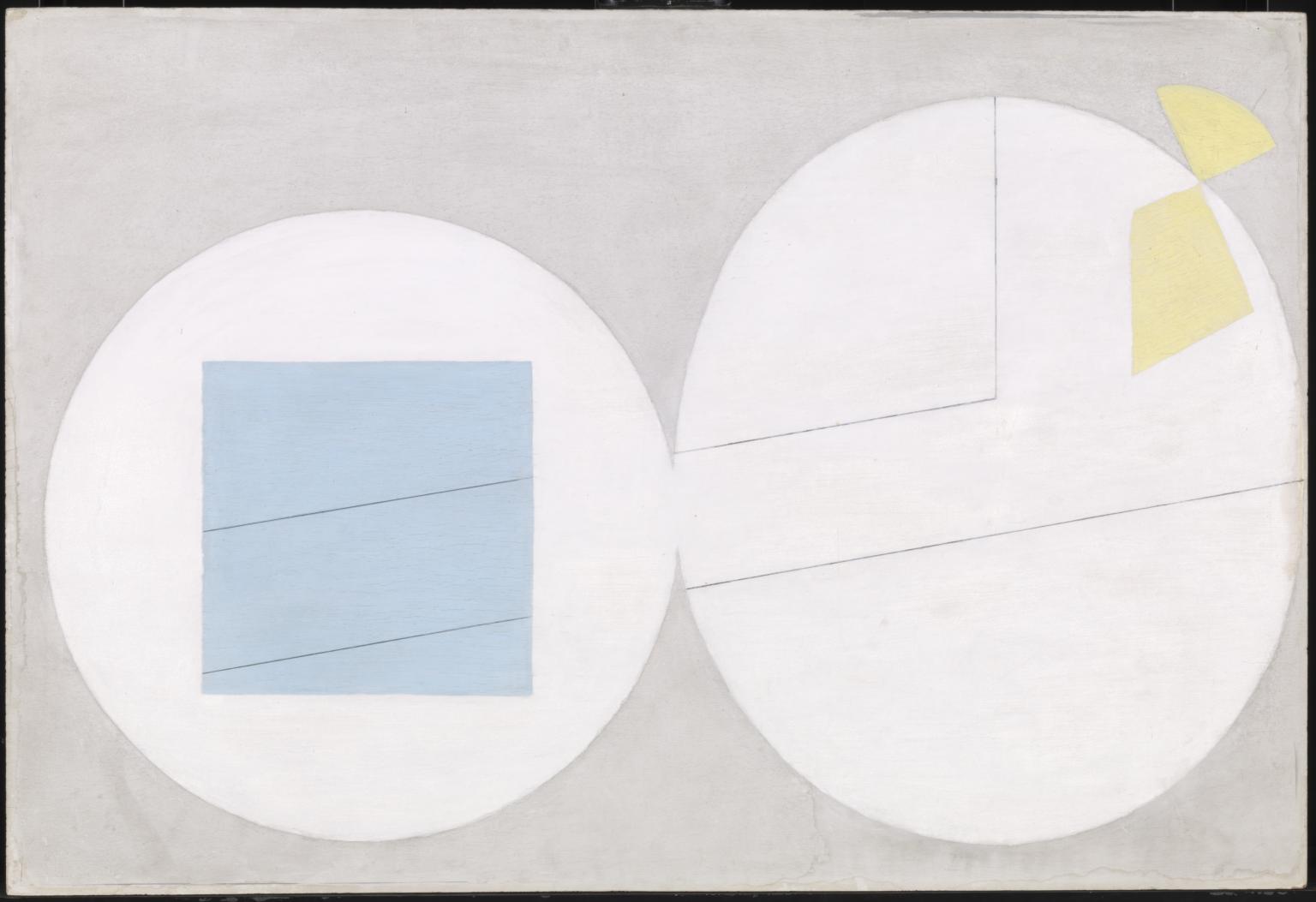
Winifred Nicholson, Quarante Huit Quai d’Auteuil 1935
The title of this work refers to Winifred Nicholson’s address in Paris, where she lived from 1932 to 1938, befriending artists such as Piet Mondrian, Constantin Brancusi, Jean Arp and Jean Hélion. Nicholson painted her first abstract paintings in 1934, exhibiting them under the name Winifred Dacre. The paintings are expressions of colour and light, and she wrote that ‘the nature of abstract colour is utter purity – but colours wish to fly, to merge, to change each other by their juxtapositions, to radiate, to shine, to withdraw deep within themselves.’
Gallery label, November 2015
4/14
artworks in International Modern
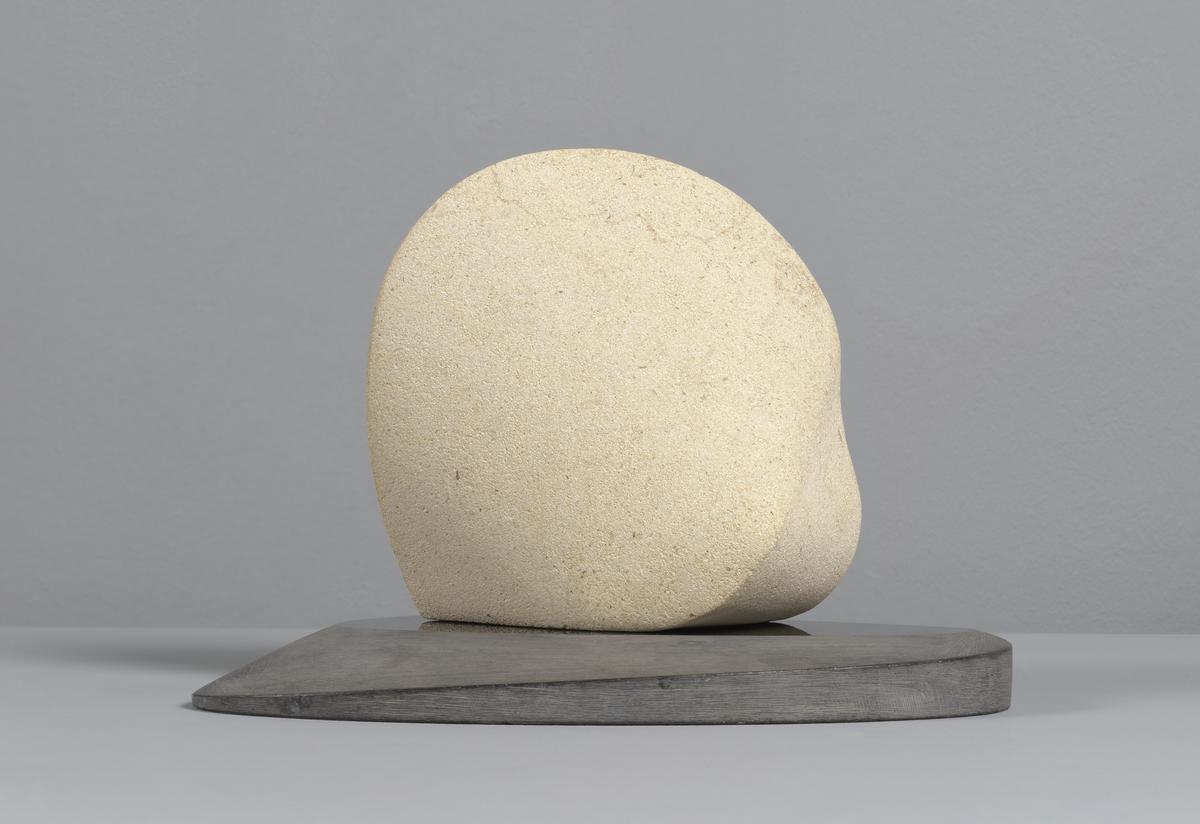
Naum Gabo, Stone with Collar c.1933
Models were an essential stage in Gabo''s working practice. He usually began with drawings, then built models, which allowed him to test the different types of materials he might use. A comparison of the models for Monument for an Airport and Spiral Theme with the finished sculptures on display in this room demonstrates the precision of his enlargement process. Two of the models incorporate pieces of stone, an idea which emerged in 1930-1.
Gallery label, August 2004
5/14
artworks in International Modern

Naum Gabo, Spheric Theme (Penetrated Variation) c.1937–40
Josef Albers 1888-1976
Born Germany, worked Germany, USA
Cables 1931
Glass
The rolls in Cables contradict the laws of perspective, reflecting Albers’ interest in the psychology of perception. He used visual trickery to highlight the disjunction between what we see and how our brains process this information. This work was made by sandblasting coloured glass, a method originally devised for engraving headstones. Albers’ interest in such techniques related to his teaching at the Bauhaus, the school of art, architecture and design founded in Germany in 1919. The Bauhaus aimed to bring art closer to everyday life, with an emphasis on design and technology.
Presented by The Josef and Anni Albers Foundation 2006T12204
Josef Albers 1888-1976
Born Germany, worked Germany, USA
Repetition Against Blue 1943
Oil on Masonite
Albers was fascinated by the nature of visual perception. The interlocking shapes of Repetition Against Blue teasingly play with ideas of perspective, and the question of what is foreground and what is background cannot be satisfactorily resolved. This work also shows his growing interest in colour, which he rigorously explored during his later years in the United States. The Bauhaus school of art and design had closed after Hitler came to power, and Albers carried its utopian ideas with him to a new teaching post at Black Mountain College in North Carolina.
Presented by The Josef and Anni Albers Foundation 2006T12214
Constantin Brancusi 1876-1957
Born Romania, worked France, USA
Fish 1926
Poisson
Bronze, metal and wood
Brancusi attempted to capture the essential qualities of a human face or an animal in abstract and elementary forms. Here a bronze 'fish' stands on a polished disc, (its 'pool'), above a carved wooden base. Brancusi explained: 'When you see a fish, you do not think of its scales, do you? You think of its speed, its floating, flashing body seen through water ... If I made fins and eyes and scales, I would arrest its movement and hold you by a pattern, or a shape of reality. I want just the flash of its spirit.'
Accepted by HM Government in lieu of tax and allocated to the Tate Gallery 1996T07107
Robert Delaunay 1885-1941
Born and worked France
Endless Rhythm 1934
Rythme sans fin
Oil paint on canvas
The coloured discs strung out diagonally across the picture are so arranged that each one leads on to the next and the movement is directed back again into the picture at the two ends. Perhaps because of this infinitely looping effect, his wife Sonia considered Endless Rhythm to be the most appropriate title. The year after painting this, Delaunay was commissioned to paint murals for the Aeronautics pavilion at the 1937 Paris International Exhibition; the resulting compositions included discs, rings and colour rhythms on a huge scale.
Purchased 1970T01233
Theo van Doesburg 1883-1931
Born and worked Netherlands
Counter-Composition VI 1925
Contre-compositie
Oil paint on canvas
Van Doesburg was the editor of De Stijl magazine and its combination of art, architecture and design reflected his own wide-ranging activities. He painted his first ‘Counter-Composition’ in 1924, using a diagonal grid to create a dynamic tension between the composition and the rectilinear format of the canvas. For van Doesburg, the shift marked a spiritual liberation from the ‘earth-bound’ verticals and horizontals used by the De Stijl group.
Purchased 1982T03374
Naum Gabo 1890-1977
Born Russia, worked Germany, France, USA
Construction in Space: Diagonal 1921-5, reassembled 1986
Glass, metal and celluloid
Most of the components of this work were discovered in Gabo's attic in 1977 and reassembled later. The long vertical elements of the original appear to have been glass, so that it would have been even more transparent. Its construction shows Gabo's interest in scientific instruments, which were familiar to him having trained in engineering and natural sciences. Indeed, this piece was originally exhibited as ‘Construction for an Observatory’.
Accepted by HM Government in lieu of tax and allocated to the Tate Gallery 1995
T06973
Naum Gabo 1890-1977
Born Russia, worked Germany, France, USA
Two Cubes (Demonstrating the Stereometric Method) 1930
Painted wood
Gabo used this work to illustrate his essay ‘Sculpture: Carving and Construction in Space’ in the anthology Circle. The two cubes show two ways of defining space in sculpture – one uses solid mass while the other expresses the form’s ‘inner space’. The latter was the key concept behind Gabo’s constructions; he sought to make the space occupied by an object visible without enclosing it. ‘Inner space’ was an example of what Gabo called the ‘Constructive idea’, where the boundaries between the object and the artist’s perceptions of that object were dissolved, so that ‘art becomes reality’.
Presented by the artist 1977T02166
Naum Gabo 1890-1977
Born Russia, worked Germany, France, USA
Construction: Stone with a Collar 1933, this version circa 1936-7
Stone, cellulose acetate, slate and brass
In the 1920s Gabo rejected sculptural mass and the use of natural materials in favour of space and industrial materials. Here, however, he brings together the expression of open space (the curvature of the cellulose acetate and the painted brass ‘collar’) with the sculptural solidity of stone resting on a slate base. In taking this direction, Gabo wished to express what he saw as the hidden forces of nature.
Accepted by HM Government in lieu of tax and allocated to the Tate Gallery 1995T06975
Naum Gabo 1890-1977
Born Russia, worked Germany, France, USA
Spheric Theme (Penetrated Variation) circa 1937-40
Bronze
Gabo lived in Britain from 1935 to 1946 and worked in Carbis Bay in Cornwall during the war. In this sculpture he creates a continuous curved surface with a single sheet of bronze, intersected by a square plane. Gabo’s pioneering theories of geometry and pure abstraction influenced a number of British artists. The innovative materials and techniques of his constructions expanded the creative possibilities for exploring space, form and movement, and artists such as Barbara Hepworth extended these ideas to their relationship with the landscape.
Presented by the artist 1977T02176
Albert Gleizes 1881-1953
Born and worked France
Painting 1921
Tableau
Gouache on wood
Gleizes developed each work very carefully, drawing the composition in pencil, then making several gouaches with varying colour possibilities before painting a final version. The abstracted image may be based on a female head, possibly that of the artist’s wife. According to this interpretation, the central image is frontal, showing the face in a cloche hat with a scarf; the second concentric set is the head again, closer, and the third gives an idea of the hair, concealed in the hat.
Purchased 1962T00550
Julio González 1876-1942
Born Spain, worked France
Head called 'The Tunnel' 1933-4
Tête dite 'Le Tunnel'
Steel
González is regarded as the pioneer of welded iron sculpture. He learned oxyacetylene welding while working at the Renault car factory during the First World War. The tensile strength of iron allowed him to create three-dimensional forms without filling in the volume, an effect that he described as ‘drawing in space’. Many of his works show a concern with the human figure, often in a highly abstracted form. In this work, a cylindrical head is placed above a trapezium neck, with suspended triangles to indicate features.
Purchased 1972T01698
Jean Hélion 1904-1987
Born France, worked France, USA
Abstract Composition 1934
Composition abstraite
Oil paint on canvas
Hélion saw himself as belonging to the second generation of abstract artists in Paris, after pioneers such as Piet Mondrian and Theo van Doesburg. He was an energetic promoter of abstract or non-figurative art, and helped to found international groups such as Art Concret and Abstraction-Création. He believed that abstract art, however radical, shared timeless values of balance, rhythm and composition with the great art of the past. In this small painting he creates a compositional unity through the visual resolution of vertical and horizontal forms and colour relationships.
Accepted by HM Government in lieu of inheritance tax and allocated to Tate 2002T07921
Jean Hélion 1904-1987
Born France, worked France, USA
Ile de France 1935
Oil paint on canvas
Hélion, one of the most prominent abstract artists in Paris in the 1930s, recorded the progress of many of his works in a studio notebook. The passage written about Ile de France reveals his doubts about the relation between abstract art and reality: ‘The oppositions are developing. The colours are becoming refined, the space more supple, but the more I advance the more evident is the attraction of nature. The space is provisionally, miraculously, filled with light but the volumes want to become complete: objects, bodies.’
Purchased 1965T00766
Barbara Hepworth 1903-1975
Born and worked Britain
Discs in Echelon 1935, cast 1959
Bronze
The title of Discs in Echelon announces its formal simplicity – the offset relation of two slightly different discs placed on a rectangular base. The discs present almost flat surfaces to each other, but the outer sides are more rounded; in elevation, a crisp edge at the discs’ upper shoulders is broadened as it descends. The original version of this work was carved directly by hand from ‘darkwood’ (possibly rosewood) in the 1930s. It was cast in bronze more than twenty years later.
Presented by the executors of the artist's estate 1980T03132
Barbara Hepworth 1903-1975
Born and worked Britain
Pierced Hemisphere II 1937-8
Hoptonwood stone on Portland stone base
Though purely geometrical as its name suggests, the form of this sculpture has some lingering associations with shells. It was made within a year by Hepworth for friends to place in their garden in Cornwall, and was displayed outdoors for many years until being acquired by Tate in 2004. Hepworth’s skill as a carver is exemplified by the spiral on the outside of the sculpture, which begins with a sharp edge, gradually softening as it proceeds, and finishes as a curved edge.
Accepted by HM Government in lieu of inheritance tax and allocated to Tate 2004T11785
Barbara Hepworth 1903-1975
Born and worked Britain
Forms in Echelon 1938
Wood
Hepworth and her husband Ben Nicholson were key figures in the modern movement in Britain in the 1930s. Their circle became increasingly important as European artists such as Naum Gabo and Piet Mondrian fled to London. This work relates to her interest in situating sculpture in the landscape: an early image showed it superimposed onto a photograph of a garden. 'The sculpture has an upward growth but the curves of the two monoliths make a closed composition which, in the open, with light all round, they create a quietness, a pause in the progress of the eye', Hepworth said.
Presented by the artist 1964T00698
Wassily Kandinsky 1866-1944
Born Russia, worked Germany, France
Swinging 1925
Schaukeln
Oil paint on board
The title of Swinging conveys the painting’s sense of dynamic movement, suggestive of the rhythms of modernity. One of the pioneers of abstract painting, Kandinsky championed a mystical approach to art. His treatise Concerning the Spiritual in Art, published in 1911, argued for art that was purified from all references to the material world. He felt that colour in particular was essential for liberating art from naturalistic appearances.
Purchased 1979T02344
Bart van der Leck 1876-1958
Born and worked Netherlands
Composition 1918
Oil paint on canvas
Van der Leck began to paint completely abstract compositions after meeting Piet Mondrian in 1916. The following year, he became a co-founder of De Stijl, the Dutch magazine that promoted a highly geometric abstract art linked to spiritual and utopian ideas. However, he soon fell out with Mondrian and the other De Stijl artists, and began to include figurative elements in his work once more. This may be one of his few wholly abstract works, though it is possible that in its early stages the composition derived from a recognisable image such as a vase of flowers.
Purchased 1966T00896
Fernand Léger 1881-1955
Born France, worked France, USA
Still Life with a Beer Mug 1921-2
Nature morte à la chope
Oil paint on canvas
After his experiences in the First World War, Léger became convinced that art should be accessible to all. He moved away from pure abstraction towards the stylised depiction of real objects, laying great emphasis on order, clarity and harmony. In the 1920s he developed a concern with geometric composition and decoration. This painting shows a relatively naturalistic still life of a workman's lunch on a table. The primary colours of the mug and tablecloth contrast with the dazzling black and white patterns in the background.
Purchased with assistance from the Friends of the Tate Gallery 1976T02035
Fernand Léger 1881-1955
Born France, worked France, USA
Leaves and Shell 1927
Feuilles et coquillage
Oil paint on canvas
Though many of Léger's paintings celebrate machine-made objects and modern city life, in the late 1920s he began to incorporate natural forms into his work. The curving line down the left-hand side of the painting softens the underlying geometric structure of horizontal and vertical lines, acting as a link to the organic shapes of leaves and shell. In turn, these naturalistic elements, with their streamlined shapes, appear closely related to the abstract parts of the image.
Purchased 1949N05907
Jacques Lipchitz 1891-1973
Born Russia, worked France, USA
Sculpture 1916
Plaster
The subject of this sculpture is a woman, seated with her legs crossed. The tall block is part of the head, and was added, according to the artist, 'to give value to the head, the back of the head.' This plaster was cast from a stone carving, which the artist said he carved himself rather than asking his assistant to copy from the model. There is a network of pencil crosses over the shellac surface, which mark 'points' for another carved copy to be made.
Presented by the Lipchitz Foundation 1982T03492
Jacques Lipchitz 1891-1973
Born Russia, worked France, USA
Seated Man with Clarinet I 1920
Homme assis à la clarinette I
Plaster
The figure of a clarinet player emerges from a series of block-like forms in this sculpture. Musical subject matter was typical of early works by the cubists Picasso and Braque, and the angular facets of this work suggest a relationship to the geometric shapes of cubist painting. The work also reflects the aesthetic ideals of purism, a movement which began after the First World War and sought to develop aspects of cubism, emphasising simplicity and harmony.
Presented by the Lipchitz Foundation 1982T03488
László Moholy-Nagy 1895-1946
Born Hungary, worked Hungary, Britain, USA
K VII 1922
Oil paint on canvas
The 'K' in the title of K VII stands for the German word Konstruktion (‘construction’), and the painting's ordered, geometrical forms are typical of Moholy-Nagy’s technocratic Utopianism. The year after it was painted, he was appointed to teach the one year-preliminary course at the recently founded Bauhaus in Weimar. Moholy-Nagy’s appointment signalled a major shift in the school’s philosophy away from its earlier crafts ethos towards a closer alignment with the demands of modern industry, and a programme of simple design and unadorned functionalism.
Purchased 1961T00432
Ben Nicholson 1894-1982
Born and worked Britain
1934 (relief) 1934
Oil paint on wood
Like the cubists, Nicholson was interested in the ways in which paintings can represent space. In the 1930s, he made shallow reliefs in which areas of different depths define actual space. In the most radical of these, colour was reduced to just white or grey to achieve a sense of purity. Depth and plain colour make the play of light and shadow an intrinsic part of the work. This emphasis was related to new ideas about living and, especially, to modern architecture, in which natural light and formal simplicity were major concerns.
Purchased 1978T02314
Ben Nicholson 1894-1982
Born and worked Britain
1937 (relief) 1937
Oil paint on board
Although many of Nicholson's reliefs were large, he also explored the possibilities of this type of work on a tiny scale. Because of their apparent austerity and relationship with modern architecture, Nicholson's reliefs have often been seen as cold and mechanistic, but on close inspection their handmade qualities come through in brush marks and surface irregularities.
Accepted by HM Government in lieu of tax and allocated to the Tate Gallery 1995T07006
Winifred Nicholson 1893-1981
Born Britain, worked Britain, France
Quarante Huit Quai d'Auteuil 1935
Oil paint on board
This painting was illustrated in the journal Circle. The title refers to Winifred Nicholson’s address in Paris, where she lived from 1932 to 1938, befriending leading artists such as Piet Mondrian, Constantin Brancusi, Jean Arp and Jean Hélion. Nicholson painted her first abstract paintings in 1934, exhibiting them under the name Winifred Dacre. The paintings are expressions of colour and light, and she wrote in Circle that ‘[t]he nature of abstract colour is utter purity – but colours wish to fly, to merge, to change each other by their juxtapositions, to radiate, to shine, to withdraw deep within themselves.’
Purchased 1975T01995
Winifred Nicholson 1893-1981
Born Britain, worked Britain, France
Moonlight and Lamplight 1937
Oil paint on canvas
Having embraced abstraction, Nicholson contended that ‘material resemblances were of no account - and that art could be valid without resemblances to physical objects’.
Writing the year Moonlight and Lamplight was painted, Nicholson stated that she was ‘using colour to express colour - the form could take whatever form the colour wanted’. She was ‘never interested in form, or shape or volume or mass to express colour,’ but ‘studied the way the rainbow prisms break up white light into colour and ... the balance and pose of the weight of one colour against another’.
Purchased 1975T01996
Amédée Ozenfant 1886-1966
Born France, worked France, Britain, USA
Glasses and Bottles circa 1922-6
Verres et bouteilles
Oil on canvas
Ozenfant co-founded a style of painting known as purism, which applied the principles of classical proportion to products of the machine age. The fluting of the bottles in this painting recalls classical columns, and is echoed in the various neighbouring forms. These rhythmic relationships create a harmonious unity, which embodies Ozenfant’s belief that order gives rise to aesthetic experience. He wrote, ‘The highest delectation of the human mind is the perception of order, and the greatest human satisfaction is the feeling of collaboration or participation in this order’.
Purchased 1962T00551
Georges Vantongerloo 1886-1965
Born Belgium, worked Belgium, Netherlands, France
Interrelation of Volumes 1919
Rapport des volumes
Sandstone
Vantongerloo’s aim was to ‘render visible the beauty of space’. This work is one of his earliest abstract sculptures. It attempts to give solid form to the relationships between pure, geometric shapes. Vantongerloo made contact with the De Stijl group while working in The Hague in 1917. He immediately began experimenting with abstraction. ‘If in sculpture, the interrelation of volumes achieves unity’ he wrote, ‘it is because everything is balanced.’
Purchased 1978T02306
___________________________________________________________________________
Georges Vantongerloo 1886-1965
Born Belgium, worked Belgium, Netherlands, France
No. 98 2478 Red/135 Green 1936
No. 98 2478 rouge/135 vert
Oil paint on wood
Vantongerloo was one of the pioneers of a mathematical approach to abstract art. The first number in the title, ’No.98’, is simply the figure Vantongerloo gave the work in his own catalogue. The rest of the numbers represent units of space in the painting. The basic unit (1) is the white rectangle and green stripe on the left of the bottom row. The second and third spaces along are each equivalent to two of these rectangles. Adding these numbers (1, 2, 2) cumulatively results in 1, 3 (1 2), 5 (3 2) for the green stripe section. The red row works on the same principle to give 2,4,7,8.
Purchased 1972T01574
Paule Vézelay 1892-1984
Born Britain, worked Britain, France
Forms on Grey 1935
Oil paint on canvas
Paule Vézelay lived in Paris between 1926 and 1939, changing her name from Marjorie Watson-Williams to obscure her gender and nationality. In 1934 she joined and exhibited with Abstraction Création, a loosely knit organisation of artists in Paris dedicated to the defence of non-figurative art. Although the objects depicted in this painting suggest abstracted objects from a still-life setting, such as vases or bowls, Vézelay consistently denied that the forms in her paintings were derived from nature but were instead wholly invented.
Bequeathed by the artist 1985T03955
Paule Vézelay 1892-1984
Born Britain, worked Britain, France
Five Forms 1935
Plaster
While living in Paris, between 1926 and 1939, Paule Vézelay’s work became increasingly abstract. This is one of a small group of white plaster sculptures that she made in 1935. For Vézelay the use of simple, white, biomorphic forms suggested truth, beauty, harmony and clarity. It also offered a medium for a new political and spiritual understanding of life
Presented by the Patrons of British Art through the Tate Gallery Foundation 2000T07582
Friedrich Vordemberge-Gildewart
Born Germany, worked Germany, France
Composition No. 15 1925
Oil paint on canvas
Vordemberge-Gildewart was one of the first painters to work throughout his career in an abstract style. In 1924 he became a member of the De Stijl group and in 1932 he joined the Abstraction-Création group in Paris. Trained in interior design and architecture, Vordemberge initially made reliefs and sculptures. By 1923, he wrote, he 'started making deliberate use of colour' in making paintings. This is one of his earliest paintings and exemplifies what he called 'Absolute art'; namely art without content or object. Colour, form, contrast and space were the only objects.
Purchased 1971T01474
Gallery label, May 2012
6/14
artworks in International Modern
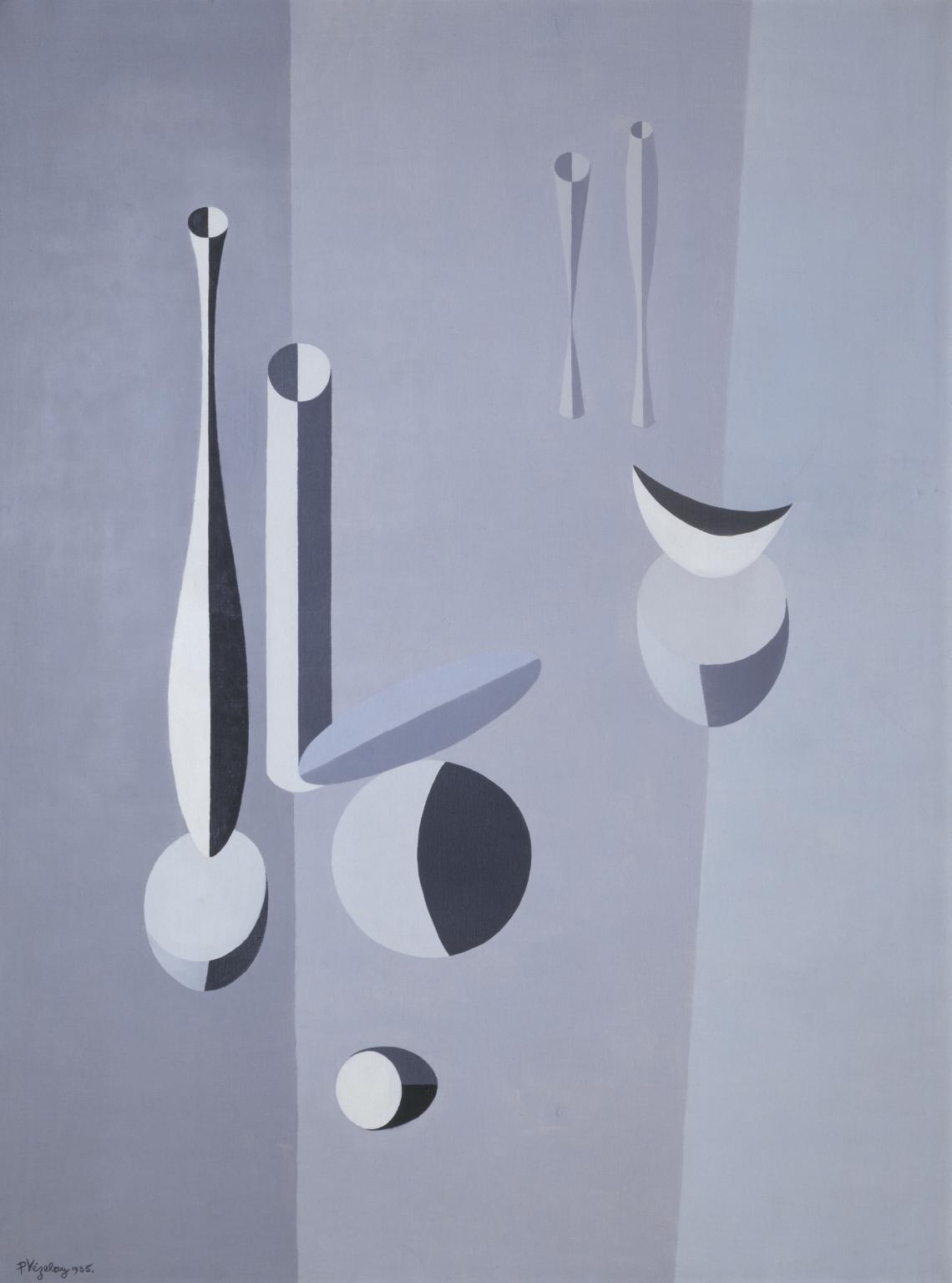
Paule Vézelay, Forms on Grey 1935
Paule Vézelay lived in Paris between 1926 and 1939, changing her name from Marjorie Watson-Williams to obscure her gender and nationality. In 1934 she joined and exhibited with Abstraction-Création, a loosely knit organisation of artists in Paris dedicated to the defence of non-figurative art. Although the objects depicted in this painting suggest abstracted objects from a still-life setting, such as vases or bowls, Vézelay consistently denied that the forms in her paintings were derived from nature but were instead wholly invented.
Gallery label, April 2012
7/14
artworks in International Modern
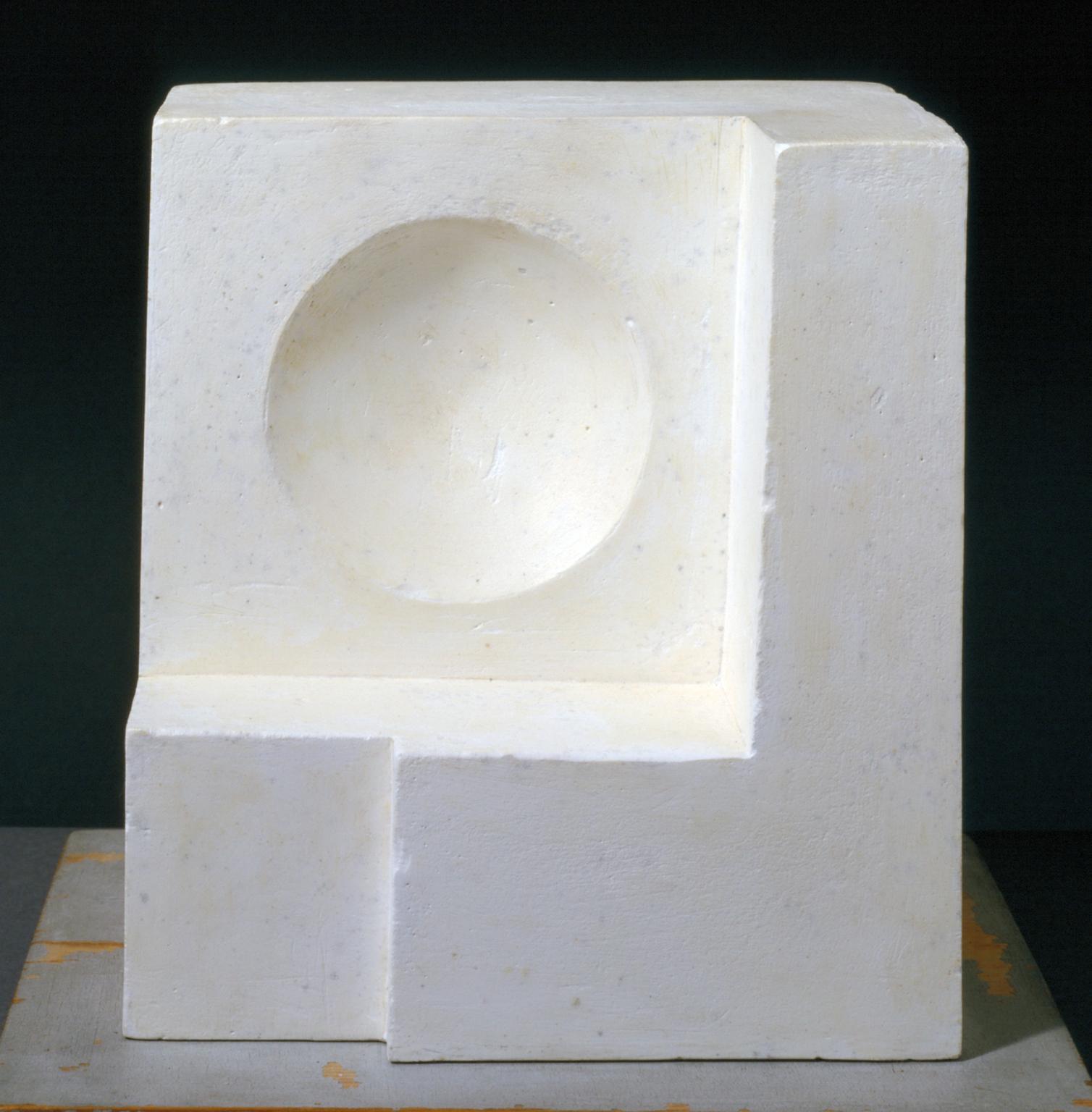
Ben Nicholson OM, 1936 (white relief sculpture - version 1) 1936
This work, in carved plaster, is one of only two known surviving sculptures by Nicholson. Both are in the Tate collection. The second is a painted hardwood carving, 'c.1936 (sculpture)', displayed nearby. Nicholson's practice of carving reliefs led him naturally to explore the possibility of making sculpture, which he was encouraged to do while sharing a studio with Barbara Hepworth. This piece was shown at the Duncan Miller Showrooms, London, in 1936, in an exhibition called 'Modern Painting for Modern Rooms', which was intended to demonstrate the integration of contemporary art with the contemporary habitat. Nicholson reported that he made four sculptures in March 1936, two in wood and two in plaster.
Gallery label, September 2004
8/14
artworks in International Modern

Paule Vézelay, Five Forms 1935
Paule Vézelay 1892–1984Five Forms 1935PlasterBristol-born Marjorie Watson-Williams adopted the name Paule Vézelay while living in Paris between 1926 and 1939. During this time her work became increasingly abstract. Vézelay was interested in how art might convey new forms of political and spiritual understanding. Five Forms is one of a small group of white plaster sculptures Vézelay made in 1935. The use of simple, white, biomorphic forms suggests truth, beauty, harmony and clarity.Presented by the Patrons of British Art through the Tate Gallery Foundation 2000T07582
Gallery label, June 2019
9/14
artworks in International Modern
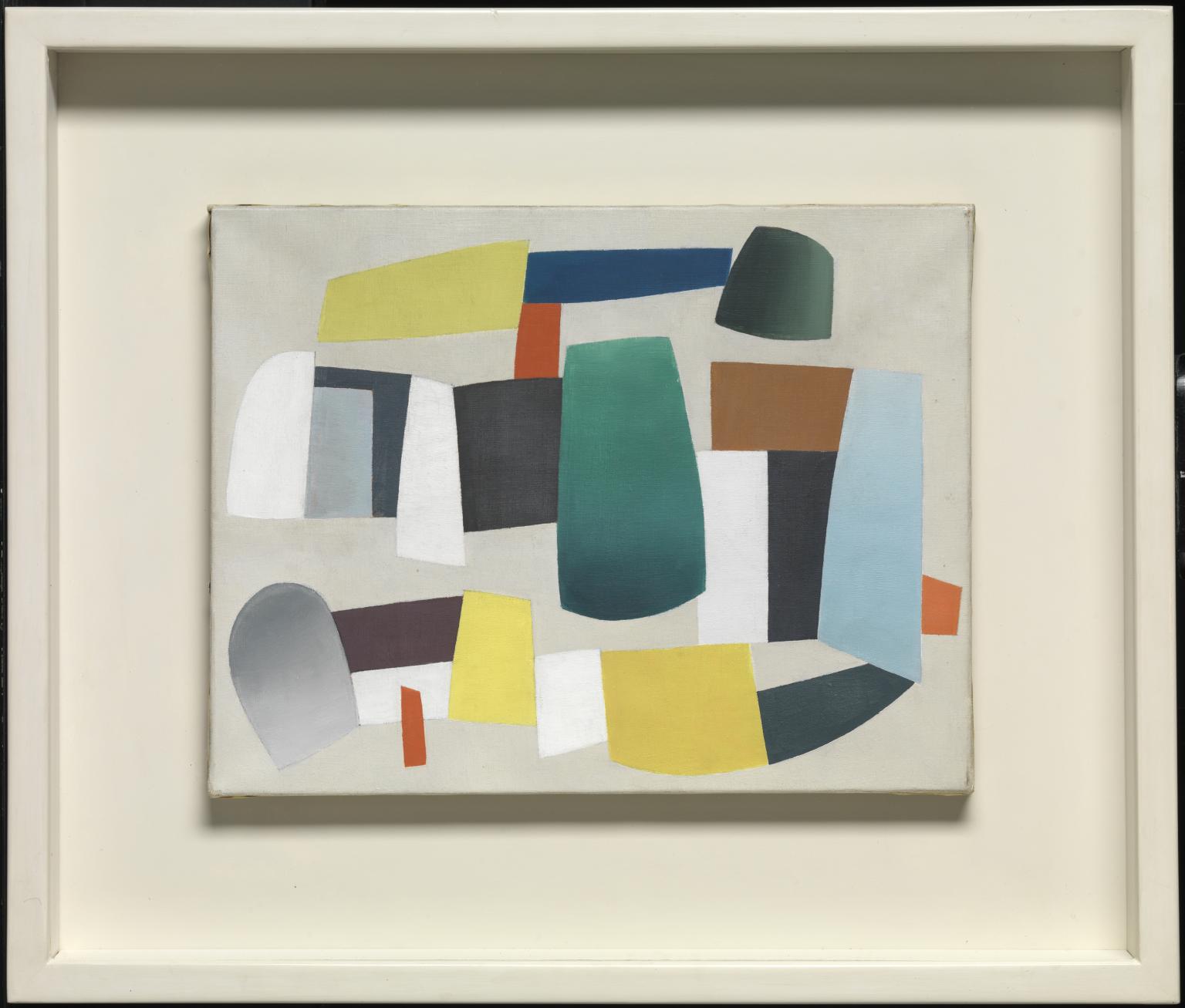
Jean Hélion, Abstract Composition 1934
Hélion was an energetic promoter of abstract or non-figurative art. He believed qualities such as balance, rhythm and composition linked the most radical abstract art and the great art of the past. He helped to found the groups Art Concret and Abstraction-Création as forums for like-minded artists. These groups were deliberately international in outlook at a time of political nationalism and intolerance across Europe.
Gallery label, January 2019
10/14
artworks in International Modern
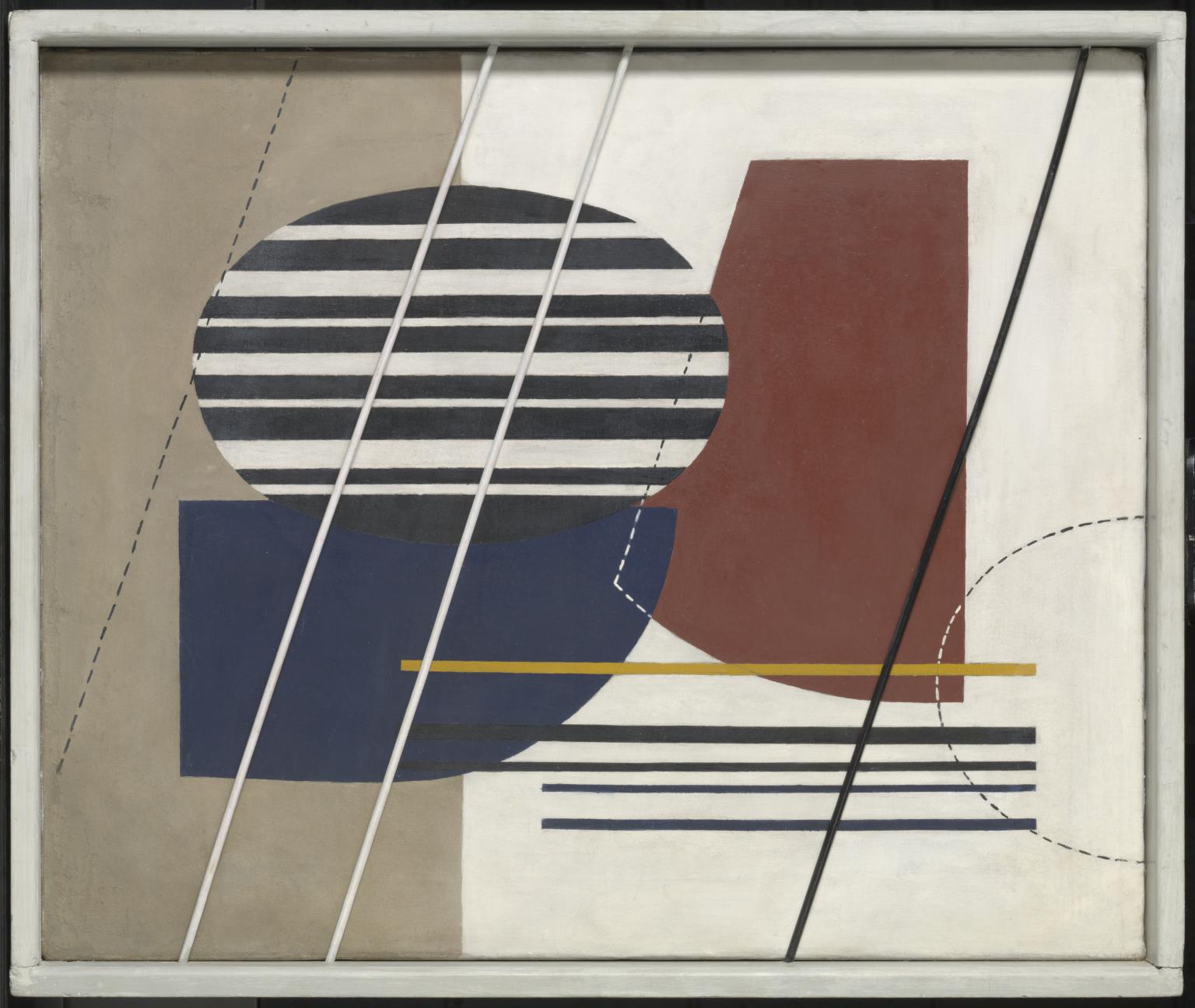
John Piper, Construction, Intersection 1934
Piper made this construction after seeing an exhibition of reliefs in Paris by Cesar Domela, an associate of De Stijl, the Dutch modernist group.
Piper first exhibited his constructions in London in 1935. One critic said they were made ‘from hunks of cable, rods, drums, ribbed lavatory panes, strips of perforated bluebottle-metal, etc.’ To him they suggested ‘underground wiring diagrams, or nightmare relief maps such as a neat and gifted electrician might improvise in sleep’. Rational diagrams appealed strongly to Modernist artists but these shapes probably recall nautical objects such as masts, buoys and floats.
Gallery label, February 2010
11/14
artworks in International Modern
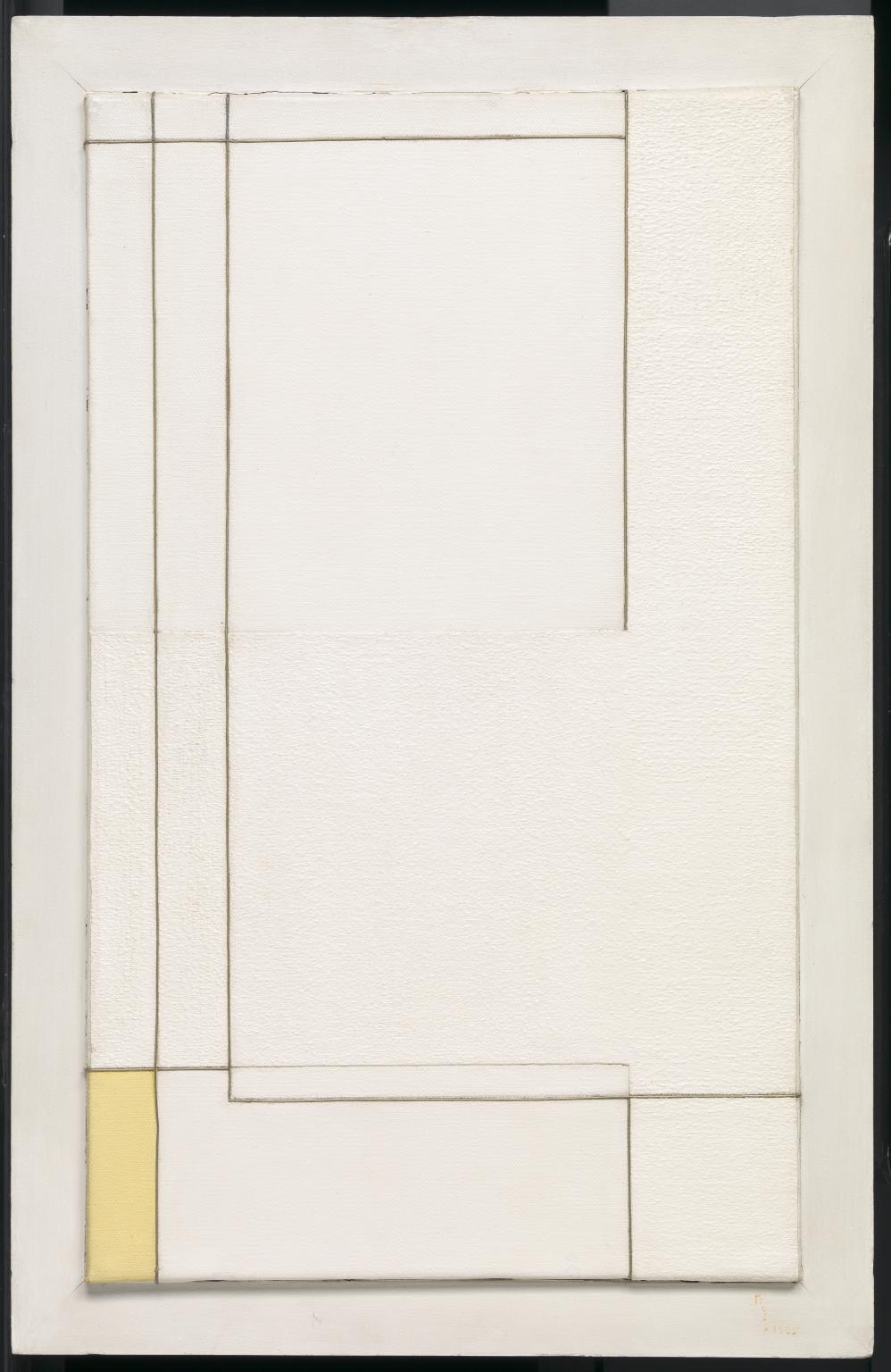
Marlow Moss, White and Yellow 1935
12/14
artworks in International Modern
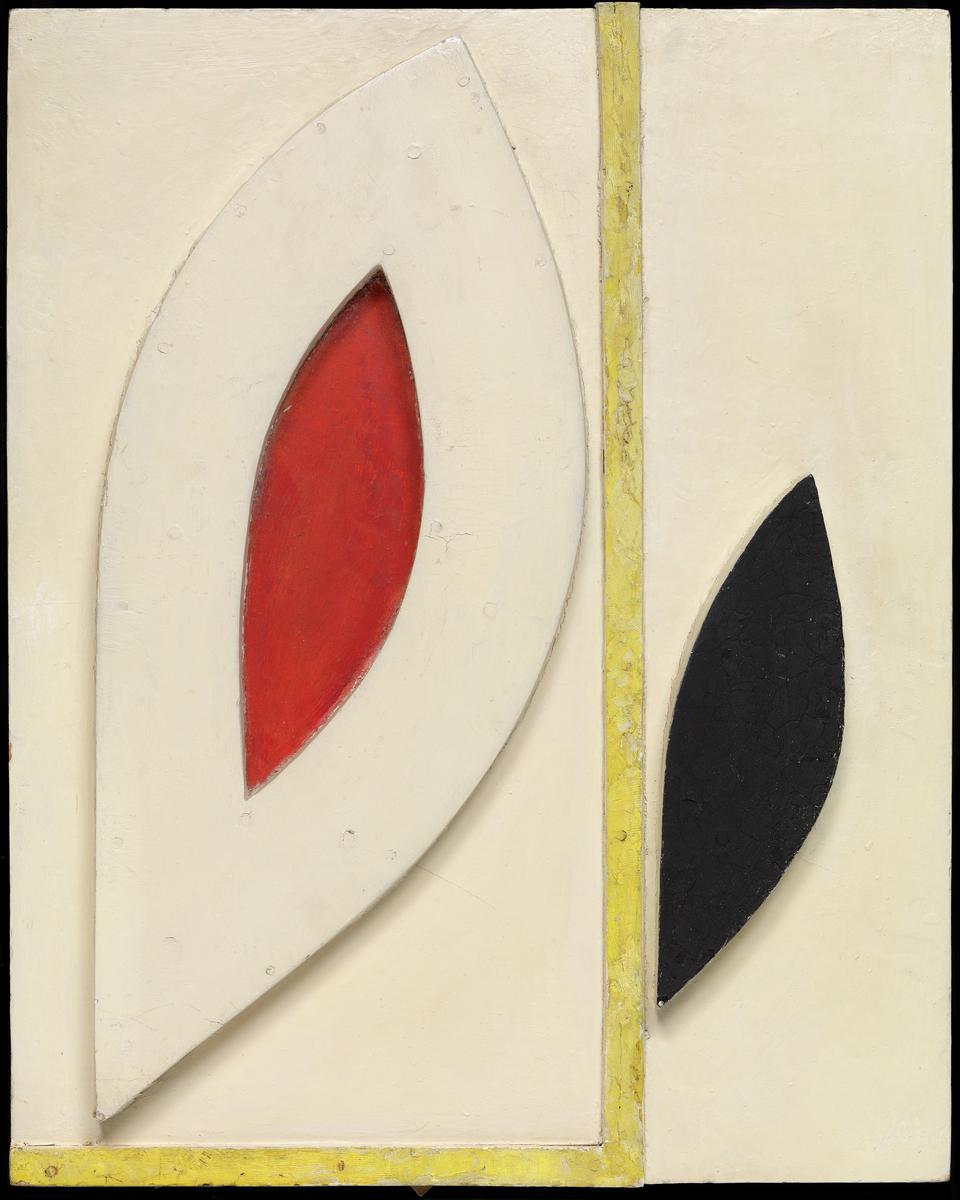
Kurt Schwitters, Untitled (White Construction) 1942
Schwitters came to Britain in 1940 as a refugee from Germany. He was held in a prison camp on the Isle of Man when he first arrived. This work was made after his release, when he was newly settled in London. The leaf-like shapes reflect the interest in the natural world that dominated Schwitters’s work from the 1930s. Its simple forms, combining flat areas of primary colour with white and black resemble his abstract painted reliefs of the 1920s. In 1942 he exhibited with leading figures in British abstraction and surrealism in the touring exhibition New Movements in Art.
Gallery label, April 2019
13/14
artworks in International Modern
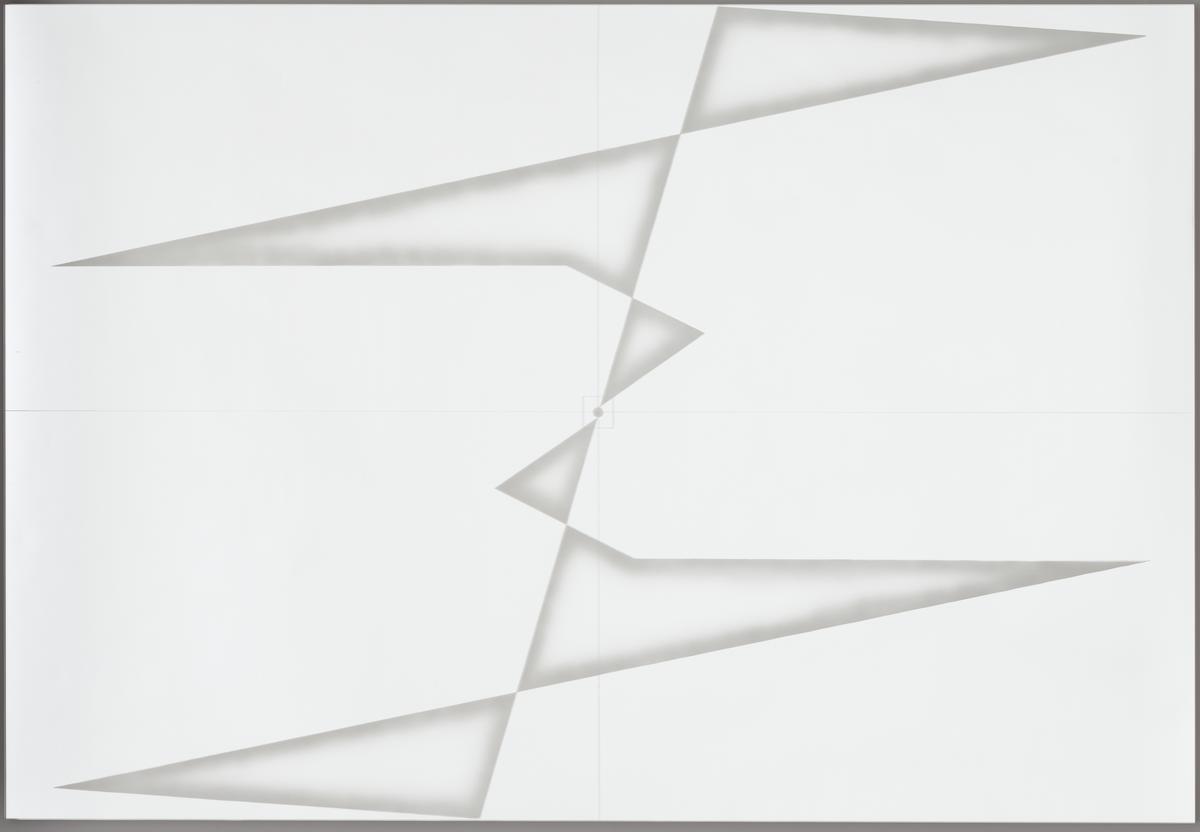
Goshka Macuga, Drawing no.4 ‘Path of Movement of a Point’ after K. Malevich (1922) 2003
Drawing no.4 ‘Path of Movement of a Point’ after K. Malevich (1922) 2003 is a rectangular mirror etched with six triangular shapes arranged point to point to form a diagonal line spanning from the top to the bottom of the image. A single small circle sits at the centre of the composition between the two smallest triangles. The work is part of a series inspired by the drawings and sketches of Russian suprematist Kasimir Malevich (1879–1935) and was first shown at Bloomberg Space in London as part of a specifically commissioned solo exhibition titled Kabinett der Abstrakten in 2003. Here, Drawing no.4 ‘Path of Movement of a Point’ after K. Malevich (1922) was shown alongside Arkhitectony – after K. Malevich 2003, towering wooden plinths designed for the display of objects, artefacts and sculptures that took their form from Malevich’s plaster studies of radical architectural form called Architecktons. In the leaflet accompanying the exhibition, Macuga wrote of her interest in Malevich’s practice:
14/14
artworks in International Modern
Art in this room














You've viewed 6/14 artworks
You've viewed 14/14 artworks
Responses
-
Goshka Macuga Drawing no.4 ‘Path of Movement of a Point’ after K. Malevich (1922)
2003On display at Tate Britain part of Historic and Modern British Art

